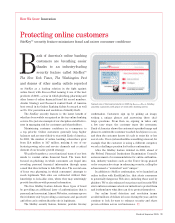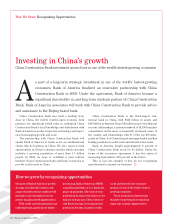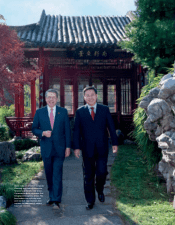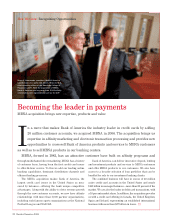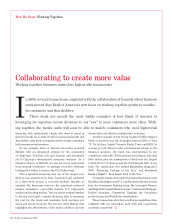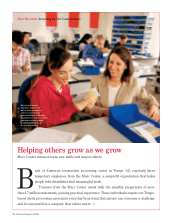Bank of America 2005 Annual Report Download - page 30
Download and view the complete annual report
Please find page 30 of the 2005 Bank of America annual report below. You can navigate through the pages in the report by either clicking on the pages listed below, or by using the keyword search tool below to find specific information within the annual report.
ank of America in 2005 embarked
on a mission to fulfi ll an unprec-
edented decade-long, $1.5 billion
philanthropic goal, making the
bank one of the most generous corporations
in the country based on cash donations.
B
As part of this 10-year goal, the company will donate
$200 million in 2006. The bank will meet this goal through
a national strategy called “neighborhood excellence,” under
which the bank works with local community leaders to iden-
tify and meet the most pressing needs in each neighborhood.
Our emphasis on community building is the catalyst for the
Neighborhood Excellence Initiative—the bank’s signature
philanthropic program. In 2005 the bank committed more
than $30 million to the program in 38 markets nationwide.
The Neighborhood Excellence Initiative consists of
three components: Student Leaders, Local Heroes and
Neighborhood Builders. Student Leaders are exemplary
high school students with an interest in improving their
neighborhoods. Bank of America provides funding for each
student to participate in a paid, eight-week summer intern-
ship with a community-based organization as well as a
customized mentoring relationship with a Bank of America
associate. Kayla Drozd, an exceptional high school student
from Portland, OR, recently completed her internship with
Mount Hood Habitat for Humanity. “Working closely with my
Bank of America mentor, I gained hands-on experience—not
only benefi ting my community, but bettering myself through
valuable professional experience,” says Ms. Drozd.
The bank also recognizes Local Heroes for their achieve-
ments and leadership on issues that contribute signifi cantly
to neighborhood vitality. The bank funds a $5,000 contri-
bution to an eligible nonprofi t of the Local Hero’s choice.
Michael Lesparre of Washington, DC, is one such hero.
Known as Maitre d’Lesparre, the 82-year-old World
War II veteran arrives at Miriam’s Kitchen before 6 a.m.
to help serve breakfast to more than 200 homeless guests.
“Volunteering is a wonderful, eye-opening experience,
and I truly can’t think of anything more rewarding than
Jesus Garcia, executive director of the Little Village Community
Development Corp. in Chicago, watches neighborhood children
participate in a martial arts class sponsored by Little Village.
How We Grow: Investing in Our Communities
Making a difference in our neighborhoods
The Neighborhood Excellence Initiative provides opportunity and sustains vibrant communities
giving back to the people who come here looking for a sec-
ond chance at life,” says Lesparre. Lesparre directed his
$5,000 grant from Bank of America to Miriam’s Kitchen.
The program also provides grants to Neighborhood
Builders—nonprofi ts working to promote vibrant neighbor-
hoods. Each organization receives a $200,000 grant over
two years, which can be used for operating expenses and
capacity building. Leaders from each organization also
participate in an innovative leadership training program.
This year, nonprofi t leaders from our inaugural
Neighborhood Excellence Initiative participated in sessions
in San Francisco, Chicago, Boston and Washington, DC.
Among the participants was Jesus Garcia, executive director
of Little Village Community Development Corp., an organi-
zation dedicated to violence prevention, education and eco-
nomic development on Chicago’s Southwest Side. “The Bank
of America Neighborhood Excellence Initiative is open-minded,
takes chances with newer organizations and invests capital
and other resources at critical points during development
using nonconventional criteria,” says Garcia.
Bank of America 2005 29


